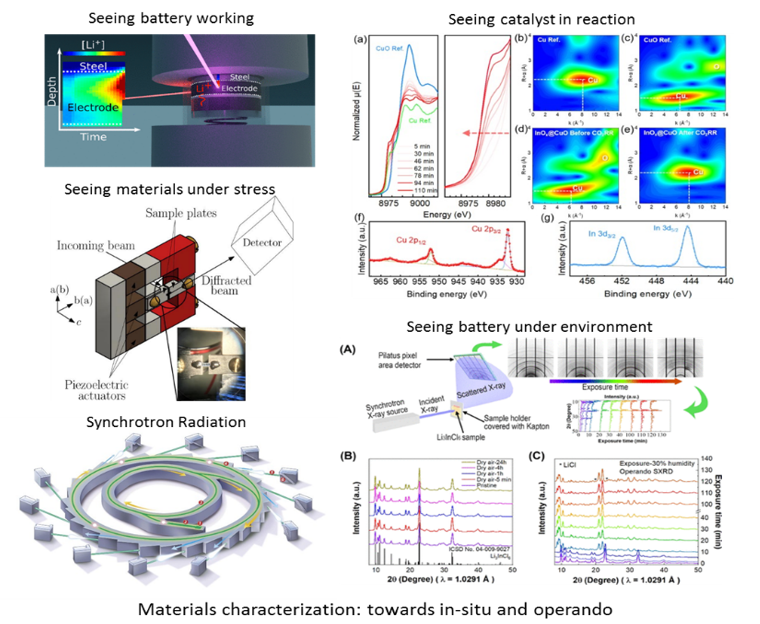Video Article Open Access
Advanced Materials Characterization using Synchrotron: Towards in-situ and Operando
Renfei Feng
Canadian Light Source, Saskatoon, S7N 2V3, Canada
Vid. Proc. Adv. Mater., Volume 3, Article ID 2208332 (2022)
DOI: 10.5185/vpoam.2022.08332
Publication Date (Web): 19 Mar 2023
Copyright © IAAM
Graphical Abstract

Abstract
Advanced materials research opens the door for many life-changing developments. Materials characterization plays an important and essential role in this research. Many of advanced characterization techniques, methods, and instruments have been developed in helping to understand structural, chemical, and functional properties of materials. Synchrotron radiation is an accelerator-based light source with extreme brightness and unique properties. Synchrotron radiation-based X-ray techniques pushes the boundaries and limits of the techniques to be much more sensitive, rapid, and with much higher spatial resolution. This enables the researches and applications which are generally not possible in the regular laboratories, such as diffraction microscopy/imaging techniques. Modern development of X-ray optics, detectors, and instrumental control mechanism has improved the detection sensitivity and speed greatly, which makes in-situ and operando materials characterization possible, i.e., measuring in real time, real location, real environment, and under real condition. This presentation will briefly discuss advanced synchrotron materials characterization techniques, including the techniques of X-Ray absorption spectroscopy, X-ray fluorescence spectroscopy/ microscopy, X-ray diffraction/microscopy, in micro-, meso- and macro-scale. The applications of these techniques in advanced materials characterization will be showcased, including green energy materials, battery materials, catalytic materials for water-splitting and CO2 capture, environmental materials for sustainability, biomaterials, and engineering materials [1-5]. A few examples of in-situ and operando characterization will be discussed in more details: (1) bulk-sensitive imaging of twin domains in LSCO under stress [1], using X-ray Laue diffraction; (2) operando tracking of solution phase concentration profiles in Li-ion battery positive electrodes [2], using X-ray fluorescence spectroscopy; (3) catalysis in reaction – CO selectivity for electrochemical CO2 reduction [3], using X-ray absorption spectroscopy; (4) phase change of halide solid-state electrolytes under normal environment (moisture instability) [4], using X-ray diffraction.
Keywords
Synchrotron radiation; x-ray diffraction; x-ray spectroscopy; materials characterization; in-situ and operando.
Acknowledgement
The work presented here is supported by the Canada Foundation for Innovation (CFI), the Natural Sciences and Engineering Research Council (NSERC), the National Research Council (NRC), the Canadian Institutes of Health Research (CIHR), the Government of Saskatchewan, and the University of Saskatchewan. Please acknowledge the funding authorities and other research supports.
References
- X.Y. Zheng, R. Feng, D.S. Ellis, Y.-J. Kim, Applied Physics Letters, 2018, 113, 071906.
- J.I.G. Dawkins, M.Z. Ghavidel, D. Chhin, I. Beaulieu, M.S. Hossain, R. Feng, J. Mauzeroll, S. Schougaard, Analytical Chemistry, 2020, 92, 10908.
- P. Sui, S. Liu, C. Xu, J. Xiao, N. Duan, R. Feng, J. Luo, Chemical Engineering Journal, 2022, 427, 131654.
- W. Li, J. Liang, M. Li, K. Adair, X. Li, Y. Hu, Q. Xiao, R. Feng, R. Li, L. Zhang, S. Lu, H. Huang, S. Zhao, T. Sham, X. Sun, Chemistry of Materials, 2020, 32, 7019.
- B. Zhao, J. Liu, C. Xu, R. Feng, P. Sui, L. Wang, J. Zhang, J. Luo, X. Fu, Advanced Functional Materials, 2021, 31, 2008812.
Biography
Renfei Feng is a Senior Scientist and the leader of a hard X-ray microprobe beamline facility at the Canadian Light Source – the national synchrotron research center in Canada. He has over 20 years’ experience in synchrotron X-ray science, and holds Adjunct Professor in University of Saskatchewan and other three universities in Canada and China. He has been instrumental in developing advanced synchrotron materials characterization techniques, including the techniques of X-Ray absorption spectroscopy, X-ray fluorescence spectroscopy/microscopy, X-ray diffraction/microscopy, in micro-, meso- and macro-scale. He has been continuously promoting the applications of these techniques to advanced materials characterization, including green energy materials, battery materials, catalytic materials for water-splitting and CO2 capture, environmental materials for sustainability, biomaterials, and engineering materials.
Dr Feng has a wide collaboration with the scientists and engineers from advanced materials sciences, and has authored 135+ publications on high-impact journals.
Video Proceedings of Advanced Materials

Upcoming Congress



